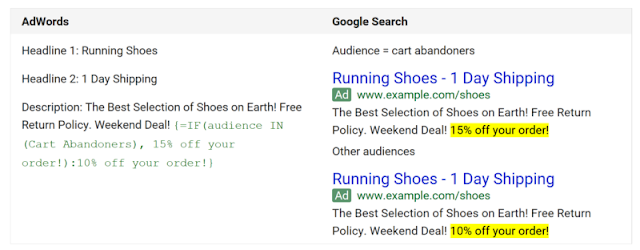First, a moment of silence for the Standard Text Ad format that held on for 15+ years. Today marks the end. And with that, Google is rolling out AdWords IF functions globally to give advertisers the ability to customize their ads in much the same way ad customizers allow, but without the feed.
With IF functions, text ads can be tailored based on whether users are on mobile and/or are members of an audience list. For example, Frederick Vallaeys wrote in his column about using the IF function for mobile last fall, when the feature was first announced, as a way for advertisers who were running mobile-preferred Standard Text Ads to continue customizing ads for mobile users.
In the example below from Google, an If function is used to customize the description offer based on whether a user is in the advertiser’s “Cart Abandoners” retargeting list. If they on the list, users will see a “15% off” promotion; if not, they’ll get a “10% off” offer.
Syntax
Broken down, the syntax for IF functions is:- Start with “{=IF”
- Add an open “(” after IF
- Follow with the targeting of “device=mobile” or “audience IN”
- If you’re using audience targeting, put the list you want to target inside parentheses. If you are targeting multiple audience lists, separate them with a comma.
- Put a comma after the targeting.
- Add the text to insert when targeting criteria is met.
- Close “)”
- Follow with a colon “:”
- After the colon, add the default text that will be used when the targeting criteria is not met.
- End with the closing curly bracket “}”
{=IF(device=mobile or audience IN(audiencelist1,audiencelist2), Custom Text): Default Text}
A few more things to note
IF functions can be used anywhere in an Expanded Text Ad except for the final URL. They are only eligible to run on the Search Network.
And last but not least, with the default text provided with IF functions, advertisers don’t have to have an ad that doesn’t use customizers in their ad groups.



No comments:
Post a Comment